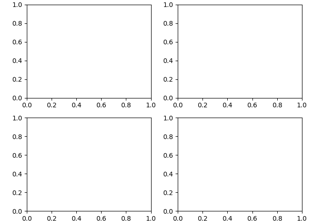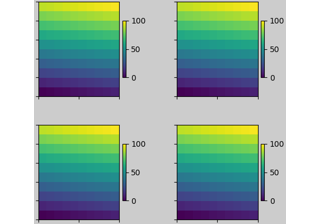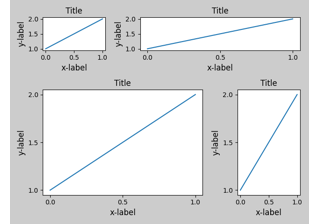matplotlib.gridspec.SubplotSpec¶
-
class
matplotlib.gridspec.SubplotSpec(gridspec, num1, num2=None)[source]¶ Bases:
objectSpecifies the location of a subplot in a
GridSpec.Note
Likely, you'll never instantiate a
SubplotSpecyourself. Instead you will typically obtain one from aGridSpecusing item-access.Parameters: - gridspec
GridSpec The GridSpec, which the subplot is referencing.
- num1, num2int
The subplot will occupy the num1-th cell of the given gridspec. If num2 is provided, the subplot will span between num1-th cell and num2-th cell inclusive.
The index starts from 0.
-
__dict__= mappingproxy({'__module__': 'matplotlib.gridspec', '__doc__': "\n Specifies the location of a subplot in a `GridSpec`.\n\n .. note::\n\n Likely, you'll never instantiate a `SubplotSpec` yourself. Instead you\n will typically obtain one from a `GridSpec` using item-access.\n\n Parameters\n ----------\n gridspec : `~matplotlib.gridspec.GridSpec`\n The GridSpec, which the subplot is referencing.\n num1, num2 : int\n The subplot will occupy the num1-th cell of the given\n gridspec. If num2 is provided, the subplot will span between\n num1-th cell and num2-th cell *inclusive*.\n\n The index starts from 0.\n ", '__init__': <function SubplotSpec.__init__>, '__repr__': <function SubplotSpec.__repr__>, '_from_subplot_args': <staticmethod object>, 'num2': <property object>, '__getstate__': <function SubplotSpec.__getstate__>, 'get_gridspec': <function SubplotSpec.get_gridspec>, 'get_geometry': <function SubplotSpec.get_geometry>, 'get_rows_columns': <function SubplotSpec.get_rows_columns>, 'rowspan': <property object>, 'colspan': <property object>, 'get_position': <function SubplotSpec.get_position>, 'get_topmost_subplotspec': <function SubplotSpec.get_topmost_subplotspec>, '__eq__': <function SubplotSpec.__eq__>, '__hash__': <function SubplotSpec.__hash__>, 'subgridspec': <function SubplotSpec.subgridspec>, '__dict__': <attribute '__dict__' of 'SubplotSpec' objects>, '__weakref__': <attribute '__weakref__' of 'SubplotSpec' objects>})¶
-
__eq__(self, other)[source]¶ Two SubplotSpecs are considered equal if they refer to the same position(s) in the same
GridSpec.
-
__init__(self, gridspec, num1, num2=None)[source]¶ Initialize self. See help(type(self)) for accurate signature.
-
__module__= 'matplotlib.gridspec'¶
-
__weakref__¶ list of weak references to the object (if defined)
-
get_geometry(self)[source]¶ Return the subplot geometry as tuple
(n_rows, n_cols, start, stop).The indices start and stop define the range of the subplot within the
GridSpec. stop is inclusive (i.e. for a single cellstart == stop).
-
get_position(self, figure, return_all=False)[source]¶ Update the subplot position from
figure.subplotpars.
-
get_rows_columns(self)[source]¶ [Deprecated] Return the subplot row and column numbers as a tuple
(n_rows, n_cols, row_start, row_stop, col_start, col_stop).Notes
Deprecated since version 3.3.
-
get_topmost_subplotspec(self)[source]¶ Return the topmost
SubplotSpecinstance associated with the subplot.
-
property
num2¶
-
subgridspec(self, nrows, ncols, **kwargs)[source]¶ Create a GridSpec within this subplot.
The created
GridSpecFromSubplotSpecwill have thisSubplotSpecas a parent.Parameters: - nrowsint
Number of rows in grid.
- ncolsint
Number or columns in grid.
Returns: Other Parameters: - **kwargs
All other parameters are passed to
GridSpecFromSubplotSpec.
See also
Examples
Adding three subplots in the space occupied by a single subplot:
fig = plt.figure() gs0 = fig.add_gridspec(3, 1) ax1 = fig.add_subplot(gs0[0]) ax2 = fig.add_subplot(gs0[1]) gssub = gs0[2].subgridspec(1, 3) for i in range(3): fig.add_subplot(gssub[0, i])
- gridspec


